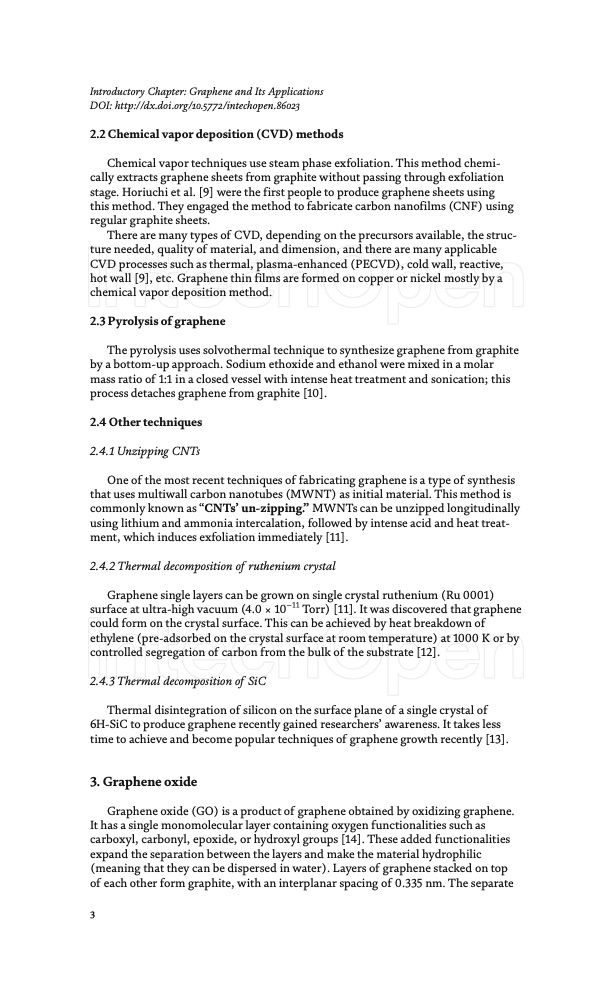PDF Publication Title:
Text from PDF Page: 005
Introductory Chapter: Graphene and Its Applications DOI: http://dx.doi.org/10.5772/intechopen.86023 2.2 Chemical vapor deposition (CVD) methods Chemical vapor techniques use steam phase exfoliation. This method chemi- cally extracts graphene sheets from graphite without passing through exfoliation stage. Horiuchi et al. [9] were the first people to produce graphene sheets using this method. They engaged the method to fabricate carbon nanofilms (CNF) using regular graphite sheets. There are many types of CVD, depending on the precursors available, the struc- ture needed, quality of material, and dimension, and there are many applicable CVD processes such as thermal, plasma-enhanced (PECVD), cold wall, reactive, hot wall [9], etc. Graphene thin films are formed on copper or nickel mostly by a chemical vapor deposition method. 2.3 Pyrolysis of graphene The pyrolysis uses solvothermal technique to synthesize graphene from graphite by a bottom-up approach. Sodium ethoxide and ethanol were mixed in a molar mass ratio of 1:1 in a closed vessel with intense heat treatment and sonication; this process detaches graphene from graphite [10]. 2.4 Other techniques 2.4.1 Unzipping CNTs One of the most recent techniques of fabricating graphene is a type of synthesis that uses multiwall carbon nanotubes (MWNT) as initial material. This method is commonly known as “CNTs’ un-zipping.” MWNTs can be unzipped longitudinally using lithium and ammonia intercalation, followed by intense acid and heat treat- ment, which induces exfoliation immediately [11]. 2.4.2 Thermal decomposition of ruthenium crystal Graphene single layers can be grown on single crystal ruthenium (Ru 0001) surface at ultra-high vacuum (4.0 × 10−11 Torr) [11]. It was discovered that graphene could form on the crystal surface. This can be achieved by heat breakdown of ethylene (pre-adsorbed on the crystal surface at room temperature) at 1000 K or by controlled segregation of carbon from the bulk of the substrate [12]. 2.4.3 Thermal decomposition of SiC Thermal disintegration of silicon on the surface plane of a single crystal of 6H-SiC to produce graphene recently gained researchers’ awareness. It takes less time to achieve and become popular techniques of graphene growth recently [13]. 3. Graphene oxide Graphene oxide (GO) is a product of graphene obtained by oxidizing graphene. It has a single monomolecular layer containing oxygen functionalities such as carboxyl, carbonyl, epoxide, or hydroxyl groups [14]. These added functionalities expand the separation between the layers and make the material hydrophilic (meaning that they can be dispersed in water). Layers of graphene stacked on top of each other form graphite, with an interplanar spacing of 0.335 nm. The separate 3PDF Image | Graphene and Its Applications

PDF Search Title:
Graphene and Its ApplicationsOriginal File Name Searched:
GrapheneChapterPublished.pdfDIY PDF Search: Google It | Yahoo | Bing
Salgenx Redox Flow Battery Technology: Power up your energy storage game with Salgenx Salt Water Battery. With its advanced technology, the flow battery provides reliable, scalable, and sustainable energy storage for utility-scale projects. Upgrade to a Salgenx flow battery today and take control of your energy future.
CONTACT TEL: 608-238-6001 Email: greg@infinityturbine.com (Standard Web Page)